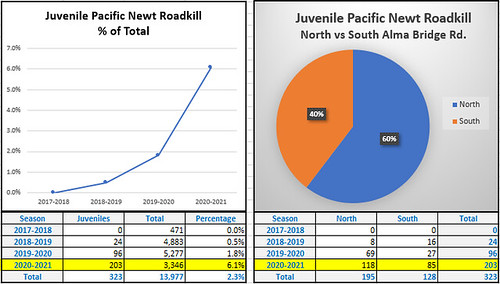Juvenile Newt Mortality at Lexington Reservoir (2019-2021)
Updated 2/19/21
The following graphs show the number of juveniles killed by vehicle collision on Alma Bridge Rd. at Lexington Reservoir between Jan. 2019 - Feb 2021.
Figure 1 shows that many more juveniles have been killed this year compared to previous migration seasons (~6% of total deaths). More than twice as many have been killed this year compared to last year. Also, more juveniles are killed in December than any other month, probably because juveniles begin to disperse from the lakes and streams in late fall with the first rains.
Figure 2 shows both juvenile and sub-adult newt mortality by newt size and migration season. Note that we didn't collect data on juveniles during the first season (2017-2018).
Figure 3a shows the large increase in percentage of juvenile vs adults killed per season; Figure 3b shows that juvenile newt mortality is more severe in the northern half of our study area, which is recreational, compared to the southern half, which is residential.
Figure 4 shows juvenile newt mortality by newt size and migration season. These pie charts show the relative number of juveniles in each size category. (NR means the newt wasn't measured because no there was no reference scale in the picture or the newt was too smashed to accurately measure.)






 Usá ArgentiNat con app iNaturalist
Usá ArgentiNat con app iNaturalist






Comentarios
@merav, @tyap, this is alarming - 18% of the newt mortalities so far this season are juveniles.
@joescience1, please join this project so you can add any juveniles you find during your surveys.
https://www.inaturalist.org/projects/pacific-newts-dead-juveniles-lexington-reservoir
Thanks for creating this, Anne. I wonder if we didn't note some newts were juveniles last year, or if we missed some? They are easily missed.
In any case, interesting trend!
@merav, I'm sure we missed some. Especially the bigger ones might be mistaken for adults, and if there aren't any measurements, it's really hard to tell from pictures alone. You were really diligent in marking the juveniles, and since you used your hand as a measurement tool, it's fairly easy to find your juveniles.
I looked at my pictures from 2017-2018 and early 2019 and couldn't detect any juveniles from the pictures. Since I didn't know it was important back then, I might not have noted all the juveniles. In some cases I measured the small ones. Other times, if I didn't have a ruler, I placed a Coast Live Oak leaf next to the juvenile to indicate relative size.
We can always improve our methods. If we start being more rigorous this year, maybe we'll have some significant data that someone can publish.
I agree. we keep learning. why didn't we use a ruler before? not sure.
Probably because we didn't know it was so important.
I found an existing SVL annotation, so I'll work on adding that to all our juvenile observations with measurements. Then we can get some metrics such as shortest, longest & average juvenile length and we'll be able to use our agreed-upon cutoff for determining if observations are juvenile or adult.
@tyap, @merav, I'm learning to use the ImageJ app to measure the newts. It's a very cool tool! I have a question for you... Do I need to save a picture of the measurements I take or can I just record the value in the SVL field in iNaturalist? This will be a fairly tedious process to measure all the juveniles, so I don't want to have to repeat it again in the future.
And, wow! I was way off in my measurement readings of the curved newts. Good thing you recommended this tool.
Hi @truthseqr, so glad to hear ImageJ is helpful and you're learning to use it! I would say saving a pic of the measurement is up to you. If it's easy to do and you want a record to refer to (for yourself or if you think others might want to double check it), then why not. But if it's a hassle, I'd say it's probably not necessary. If there's a way to note on the iNaturalist record that it was measured using ImageJ then that should be sufficient. But I would also at least save a few photos of the ImageJ measurements in case they are useful in presentations to describe how you got those measurements. My two cents. Thanks, @truthseqr!
Thanks, @tyap. I've saved screenshots of most of my ImageJ measurements (there were a couple hundred and I forgot a few screenshots, but I can easily go back and redo the analysis and get screenshots for those).
@truthseqr maybe you can write a post in one of our projects about the tool you're using, and how you're using it. You could include a few of the screenshots you took, in case someone would like to do the same thing.
@merav, I wrote instructions for using ImageJ software to calculate the newts' snout-to-vent-length (SVL):
https://www.inaturalist.org/posts/45360-how-to-measure-svl-using-imagej-software#activity_comment_6130559
Agregar un comentario